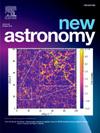The dynamical orbital stability of the proposed 2+1+1 hierarchical eclipsing binary systems
IF 2.1
4区 物理与天体物理
Q2 ASTRONOMY & ASTROPHYSICS
引用次数: 0
Abstract
We performed a comprehensive dynamical stability analysis of the eclipsing binary systems proposed to have a hierarchical structure. Using the REBOUND N-body integration package, which includes the WHFast, IAS15, MERCURIUS, and TRACE integrators, and the MEGNO (Mean Exponential Growth Factor of Close Orbits) chaos indicator, we analysed the orbital configurations of these systems and their stability on long time scales. For TZ Boo, dynamical simulations based on two proposed orbital models show that configurations with two additional companions (models I and III) exhibit significant dynamical instability, with chaotic orbital behaviour occurring on short time scales ( years). This instability is confirmed by MEGNO chaos parameters greater than 2 and the rapid divergence of the semi-major axes and eccentricities of the proposed companions. Similarly, the BB Peg and V539 Arae systems, despite being proposed to host two additional companions, also show pronounced chaotic behaviour on short timescales, as evidenced by high MEGNO values and instability times of about 708 and 458 years, respectively. In contrast, NSVS 7453183 exhibits significant dynamical stability over year simulations, supported by bounded oscillations in the orbital parameters and MEGNO values consistently below 2. The stability of the system was further validated by an analysis of the orbital parameter uncertainties, indicating the critical role of the high eccentricity dynamics in the outer companion. These results indicate the need to integrate dynamical analyses with observational constraints to assess the plausibility of additional companions in binary systems. While NSVS 7453183 provides a plausible quadruple system configuration, the results for TZ Boo, BB Peg, and V539 Arae suggest against over-reliance on diagram modelling without detailed stability evaluations.
提出的2+1+1分层食双星系统的动态轨道稳定性
我们对具有2+1+1层次结构的食双星系统进行了全面的动力学稳定性分析。利用包含WHFast、IAS15、MERCURIUS和TRACE集成商的反弹n体集成包和MEGNO(近轨道平均指数增长因子)混沌指标,分析了这些系统的轨道构型及其长时间尺度上的稳定性。对于TZ Boo,基于两种提出的轨道模型的动力学模拟表明,具有两个附加伴星(模型I和III)的构型表现出显著的动力学不稳定性,在短时间尺度(~ 103年)上发生混沌轨道行为。MEGNO混沌参数大于2、伴星半长轴的快速发散和偏心率证实了这种不稳定性。类似地,BB Peg和V539 Arae系统,尽管被提议拥有两个额外的伴星,在短时间尺度上也表现出明显的混沌行为,高MEGNO值和分别约708年和458年的不稳定时间证明了这一点。相比之下,nsvs7453183在108年的模拟中表现出显著的动力学稳定性,这是由轨道参数的有界振荡和MEGNO值始终低于2所支持的。通过对轨道参数不确定性的分析,进一步验证了系统的稳定性,表明了高偏心动力学在外层伴星中的关键作用。这些结果表明,需要将动力学分析与观测约束相结合,以评估双星系统中附加伴星的可行性。虽然nsv 7453183提供了一个合理的四重系统配置,但TZ Boo、BB Peg和V539 Arae的结果表明,在没有详细稳定性评估的情况下,不要过度依赖O - C图建模。
本文章由计算机程序翻译,如有差异,请以英文原文为准。
求助全文
约1分钟内获得全文
求助全文
来源期刊

New Astronomy
地学天文-天文与天体物理
CiteScore
4.00
自引率
10.00%
发文量
109
审稿时长
13.6 weeks
期刊介绍:
New Astronomy publishes articles in all fields of astronomy and astrophysics, with a particular focus on computational astronomy: mathematical and astronomy techniques and methodology, simulations, modelling and numerical results and computational techniques in instrumentation.
New Astronomy includes full length research articles and review articles. The journal covers solar, stellar, galactic and extragalactic astronomy and astrophysics. It reports on original research in all wavelength bands, ranging from radio to gamma-ray.
 求助内容:
求助内容: 应助结果提醒方式:
应助结果提醒方式:


